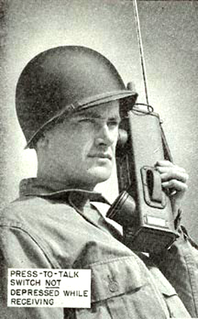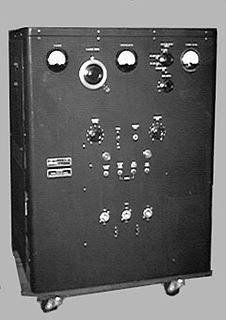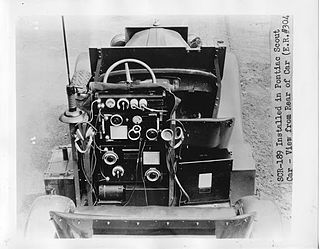
The SCR-284 was a World War II era combination transmitter and receiver used in vehicles or fixed ground stations.

The SCR-536 was a hand-held radio transceiver used by the US Army Signal Corps in World War II. It is popularly referred to as a walkie talkie, although it was originally designated a "handie talkie".

The SCR-299 was a U.S. Signal Corps mobile military communications unit used during World War II.
The SCR-197 was a ground mobile high frequency radio station used by the U.S. Army Signal Corps prior to and during World War II, notably the Battle of Wake Island in 1941.
The AN/PRC-6 is a walkie-talkie used by the U.S. military in the late Korean War era through the Vietnam War. Raytheon developed the RT-196/PRC-6 following World War II as a replacement for the SCR-536 "handy-talkie". The AN/PRC-6 operates using wide-band FM on a single crystal controlled frequency in the 47 to 55.4 MHz low band VHF band.

The BC-610 was a radio transmitter based on the Hallicrafters HT-4 and was used by the U.S. Army Signal Corps during World War II.

The SCR-300 was a portable radio transceiver used by US Signal Corps in World War II. This backpack-mounted unit was the first radio to be nicknamed a "walkie talkie".

The SCR-694 was a portable two way radio set used by the U.S. military during World War II.

The SCR-277 was a mobile, trailer mounted radio range set for radio guidance of aircraft. It was standardized by the U.S. Army in June 1941.

The BC-342 was a World War II U.S. Army Signal Corps high frequency radio receiver. It was used primarily as part of field installations such as the SCR-188A, but could be used with mobile sets such as the 2 1/2 ton mounted SCR-399. First designed at Fort Monmouth, New Jersey by the U.S. Army Signal Corps, it was built by various manufacturers including RCA. Many of the later units that are encountered today were manufactured by the Farnsworth Television and Radio Corporation of Fort Wayne, Indiana. Variants include the low frequency coverage BC-344 receiver, and the battery or dynamotor powered BC-312 receiver.
The SCR-203 was a U.S. Army radio transceiver used during World War II and designed to be mounted on an animal pack saddle.
The radio set AN/CRN-2 was an air transportable glide path transmitter used by the Army Air Force during and after World War II, the set was standardized on 5 February 1944. and was an upgrade of SCR-592.
The AN/MRN-1 was an instrument approach localizer used by the Army Air Force during and after World War II. It was standardized on 3 July 1942. It replaced the SCR-241, and was a component of SCS-51.
The AN/MRN-3 was a marker beacon set used by the Army Air Force during and after World War II, it was standardized 23 October 1943, and replaced SCR-241.

The AN/MRN-2 was a Radio Range set used by the Army Air Force during and after World War II, it replaced in part the SCR-277.
The SCR-68 was a military radiotelephone used by the US Army Signal Corps as an aircraft radio in the waning months of World War I. Due to its many problems, primarily its inability to communicate with other radios, like its ground component the SCR-67 or the larger truck mounted SCR-108, over large distances, the SCR-68 quickly became obsolete. Nonetheless, the SCR-68 was one of the first steps towards developing more effective messaging between pilots and commanders, even beyond military usage.

The SCR-108 Radio Truck was a Signal Corps Radio vehicle used by the United States Army during and after World War I for short range air-to-ground communications,

The SCR-189 was a mobile Signal Corps Radio tested by the United States Army before World War II. It was designed for armored forces, and mounted in the Six Ton Tank M1917. The original production run of these tanks included 50 "radio tanks" but the original radio components are unknown, so what or how many tanks were fitted with the SCR-189 also appears to be unknown.

The SCR-245 Radio was a mobile MF/HF Signal Corps Radio used by the U.S. Army before and during World War II, for short range ground communications, It was one of the first crystal controlled sets used by the Army.

The SCR-508 radio was a mobile Signal Corps Radio used by the U.S. Army during World War II, for short range ground communications. The SCR-508 series radio represented the Army's commitment to both FM and crystal tuning, and was used extensively by armor and mechanized units. The turret bustle of late series light and medium tanks was designed around this radio.













